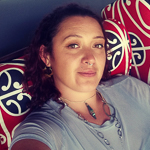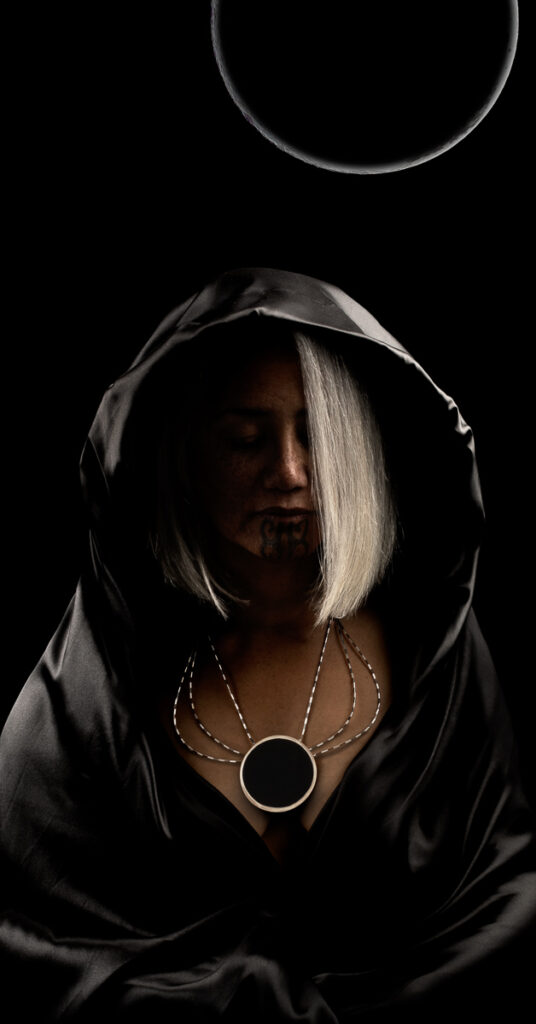Keri-Mei Zagrobelna acknowledges an ancestor spirit who protects against the chaos of the new moon
(A message to the reader.)
Ko Taranaki te maungaTaranaki is my mountain
Ko Whanganui-a-Tara toku Moana Wellington harbour is my ocean
Ko te Awakairangi te Awa Hutt river is my river
Ko Aotea te waka Aotea is my boat
Ko Te Ati Awa te Iwi Te Ati Awa is my tribe
Ko Te Tatau o te Pō te Marae Door to the night is my meeting house
Ko Moanaroa Keri-mei Zagrobelna ahau I am Moanaroa Keri-Mei Zagrobelna.
Above is an acknowledgment to my whakapapa (genealogy). Whakapapa is an important cultural principle that connects us to the environment and wairua (spiritual essence) which denotes a relationship to the Atua (gods) who represent the realms. The Maramataka is the Māori lunar calendar, an almanac and also an important cultural way of knowing and being that acknowledges environmental relationships, offers balance to everyday life and solidifies the connections between the two.
These Maramataka methodologies help Māori to understand our existing relationship with the natural environment. It is a system for observing times for harvest, rest and productivity and stems from centuries of tested, tried and lived observations. Therefore the Maramataka is a living system of codified knowledge. As a living system it can dictate changes needed from observations of our environment. I often wonder how the changing climate will affect our future indigenous practices.
Through the colonisation of Aotearoa (New Zealand) by western Europeans and the introduction of the Gregorian calendar (based on solar cycles), we saw a decline in some of these indigenous practices. The urbanisation and industrialisation of our society shifted Māori away from their traditional homelands. This created a dislocation and disconnectedness with the environment that was based around traditional methods of food gathering, planting, whānau (family) and community approaches to time. These were all aligned with the Maramataka and mātauranga—Māori world view. This living system slowly declined in practice and application, widening a separation from our Taiao, the natural environment.
Currently I am witness to a revival in Aotearoa of traditional practices within craft, lifestyle and community. The Maramataka is one of these traditional practices which assists in the decolonisation of oneself, a living system that restores and rebalances everyday life.
I incorporate Maramataka into my practice by honouring and recognising productive days for utilising work-time and also low energy phases for rest. This is a challenge in terms of living in a fast-paced society based around the Gregorian calendar but I felt it was important to also “walk the talk” to inform my work. Living within this helps to give me a deeper understanding of the Maramataka and also a connectedness to past and future ancestors.
This revival and reconnecting with the Maramataka can help restore systematic knowledge of agricultural productivity, marine and forest gathering, health, healing and daily practices that provide sustenance for well-being. Although we now no longer have the same need for hunting, fishing and foraging in contemporary society, the Maramataka still applies and, as earlier stated, can be shifted and changed in order to relate to these new methods of harvesting or health.
There is a new sense of survival that now comes in a retranslated form of the inner self-survival of being indigenous within a world that does not meet or translate to us in a way that aligns with our traditional values. Māori are adaptable. Themes around the Maramataka now hold contemporary relevance to our Atua to help navigate our everyday world.
These concepts and methods are what I am trying to examine and portray through my exhibition Whakahoki. The title and the word itself relates to some of the conceptual values of the work I have created in response to my lived experience crafting and making within the realms of the Maramataka.
Whakahoki 1. (verb) (-a) to take back, return, give back, receive (tennis, etc.), put back.2. (verb) (-a) to answer, reply, respond.3. (noun) return.4. (noun) reply, answer, response.
Maramataka is an indigenous world view and approach to healing that can save lives and heal.
I would like to highlight mental health wellbeing and how the incorporation of the Maramataka onto daily life can help to assist Māori and others well-being. Observing which nights of the calendar serve as “low or unpredictable energy” can indicate when we need to be gentle or keep watch over those that may be experiencing mental distress and it can serve as a potential preventative strategy by knowing when to self-care or step in and care for others. According to the Mental Health Foundation of New Zealand, New Zealand holds one of the highest youth suicide rates in the world in which over half of the statistics are Māori youth.
You can see an example of how I have tried to translate this through my work in the image titled “Whiro”. In astronomy, this moon phase is known as the new moon and is the first lunar phase, when the Moon and Sun have the same ecliptic longitude.
In ancient astrology practices, when both the moon and sun sit in the same Zodiac house it can cause an unbalance. In mātauranga Māori, this night is named after the god of chaos and represents low energy and is not very productive. Environmentally it is considered an unpleasant day for planting & fishing. It is a period in which to internally reflect and relax, meaning it is a good time to spend with whānau (family) and bring everyone in closer together.
In ancient cultures, obsidian disks or “mirrors” were used to scry looking into the past, present and future.
Conceptually I have realised this with the depiction of the wise woman in a black cloak trying to portray a feeling of inward contemplation and reflection. The cloak offers her a silent warmth and comfort of Te Pō (the night) in which she can safely do her internal work. A soft glow like that of the new moon appears around her highlighting that although she may look silent or in meditation there is work going on internally and she holds a soft mouth of comfort and peace. The piece is crafted from sterling silver and obsidian. In ancient cultures, obsidian disks or “mirrors” were used to scry looking into the past, present and future. Her silver piupiu threads weave up from this disk representing the weaving of centuries of knowledge and lived experience sitting on her shoulders. She is the archetype and representation of all grandmothers, mothers, daughters, sisters, aunts and nieces.
I want my audience to come away from this piece understanding that this can be a time in which they can be gentle with themselves and wrap the cloak of their ancestors around their shoulders to comfort feelings. This is a time to turn in and reflect on emotive habits or ideologies that may no longer be needed and consider releasing these. I also want my audience to know this is a time where they can offer guidance and gentle love to others like that of a kind mother or aunt. We can help those that potentially are not coping with “chaos energies” that may arise and guide these people to gently reflect and be kind to themselves so they can heal and move forward.
Taking this lesson we can build a stronger, healthier and happier society. It is not about denying or shutting down negative or darker shadow aspects of ourselves and others but recognising that there is a balance. This type of energy has a time too and it is about how we move with and through this phase when it arises.
About Keri-Mei Zagrobelna
 Keri-Mei Zagrobelna is a Wellington-born artist and art tutor that still currently resides in her hometown working from her studio on a daily basis. She graduated from Whitireia Polytech New Zealand in 2012 where she gained a BaPPa in Applied Art and Design specializing in contemporary jewellery. Her last two years of study were made possible by receiving a scholarship from The New Zealand Federation of Graduate Women. Keri-Mei was the recipient of the QUOIL mentorship and Award program upon graduation 2013 which offered her support to continue her studies within the contemporary jewellery field and was interviewed by Art Jewellery Forum. In 2015 she travelled to Slovakia to represent New Zealand in the World Art Games and continued on afterwards to exhibit and speak in Prague and in Hungary at the Eastern Europe University on her practice. She was selected by Creative New Zealand to represent New Zealand in the Aotearoa Delegation that travelled to Guam for the Pacific Arts Festival 2016. Keri-Mei was currently a part of the Handshake#4 Mentor and Mentee project and mentored by Jasmine Matzakow (Germany) and in 2018 mentored by New Zealand artist Lisa Reihana. She spoke at JEWELspeak in 2017 and also Radiant Pavilion 2019.
Keri-Mei Zagrobelna is a Wellington-born artist and art tutor that still currently resides in her hometown working from her studio on a daily basis. She graduated from Whitireia Polytech New Zealand in 2012 where she gained a BaPPa in Applied Art and Design specializing in contemporary jewellery. Her last two years of study were made possible by receiving a scholarship from The New Zealand Federation of Graduate Women. Keri-Mei was the recipient of the QUOIL mentorship and Award program upon graduation 2013 which offered her support to continue her studies within the contemporary jewellery field and was interviewed by Art Jewellery Forum. In 2015 she travelled to Slovakia to represent New Zealand in the World Art Games and continued on afterwards to exhibit and speak in Prague and in Hungary at the Eastern Europe University on her practice. She was selected by Creative New Zealand to represent New Zealand in the Aotearoa Delegation that travelled to Guam for the Pacific Arts Festival 2016. Keri-Mei was currently a part of the Handshake#4 Mentor and Mentee project and mentored by Jasmine Matzakow (Germany) and in 2018 mentored by New Zealand artist Lisa Reihana. She spoke at JEWELspeak in 2017 and also Radiant Pavilion 2019.
Her next project is Whakahoki, an exhibition of 16 works exploring the Maori Lunar calendar – Maramataka, Exhibited on the Wellington City Council Lightboxes for this year’s Matariki celebrations from June 18th to September 26th. She is also working on his first large scale public sculpture in honour of Elizabeth Knox and currently under mentorship of Rangi Kipa. Her biggest aspiration in life is to be able to set up a scholarship program for young Indigenous Māori jewellers in the hopes to offer encouragement and development within this field. This will be named in honour of her late mother and grandmother “Moanaroa”. Follow @keri_mei_z



Comments
Absolutely beautiful Keri-Mae and very inspirational.
So proud of the mahi you have done to get where you are today.
Ngā Mihi